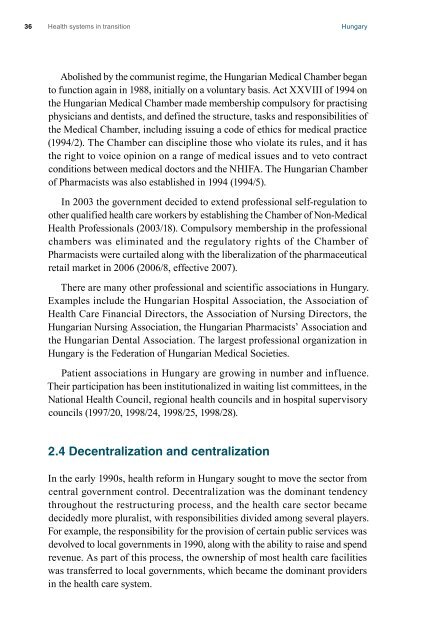Health Systems in Transition - Hungary - World Health Organization ...
Health Systems in Transition - Hungary - World Health Organization ...
Health Systems in Transition - Hungary - World Health Organization ...
You also want an ePaper? Increase the reach of your titles
YUMPU automatically turns print PDFs into web optimized ePapers that Google loves.
36<br />
<strong>Health</strong> systems <strong>in</strong> transition <strong>Hungary</strong><br />
Abolished by the communist regime, the Hungarian Medical Chamber began<br />
to function aga<strong>in</strong> <strong>in</strong> 1988, <strong>in</strong>itially on a voluntary basis. Act XXVIII of 1994 on<br />
the Hungarian Medical Chamber made membership compulsory for practis<strong>in</strong>g<br />
physicians and dentists, and def<strong>in</strong>ed the structure, tasks and responsibilities of<br />
the Medical Chamber, <strong>in</strong>clud<strong>in</strong>g issu<strong>in</strong>g a code of ethics for medical practice<br />
(1994/2). The Chamber can discipl<strong>in</strong>e those who violate its rules, and it has<br />
the right to voice op<strong>in</strong>ion on a range of medical issues and to veto contract<br />
conditions between medical doctors and the NHIFA. The Hungarian Chamber<br />
of Pharmacists was also established <strong>in</strong> 1994 (1994/5).<br />
In 2003 the government decided to extend professional self-regulation to<br />
other qualified health care workers by establish<strong>in</strong>g the Chamber of Non-Medical<br />
<strong>Health</strong> Professionals (2003/18). Compulsory membership <strong>in</strong> the professional<br />
chambers was elim<strong>in</strong>ated and the regulatory rights of the Chamber of<br />
Pharmacists were curtailed along with the liberalization of the pharmaceutical<br />
retail market <strong>in</strong> 2006 (2006/8, effective 2007).<br />
There are many other professional and scientific associations <strong>in</strong> <strong>Hungary</strong>.<br />
Examples <strong>in</strong>clude the Hungarian Hospital Association, the Association of<br />
<strong>Health</strong> Care F<strong>in</strong>ancial Directors, the Association of Nurs<strong>in</strong>g Directors, the<br />
Hungarian Nurs<strong>in</strong>g Association, the Hungarian Pharmacists’ Association and<br />
the Hungarian Dental Association. The largest professional organization <strong>in</strong><br />
<strong>Hungary</strong> is the Federation of Hungarian Medical Societies.<br />
Patient associations <strong>in</strong> <strong>Hungary</strong> are grow<strong>in</strong>g <strong>in</strong> number and <strong>in</strong>fluence.<br />
Their participation has been <strong>in</strong>stitutionalized <strong>in</strong> wait<strong>in</strong>g list committees, <strong>in</strong> the<br />
National <strong>Health</strong> Council, regional health councils and <strong>in</strong> hospital supervisory<br />
councils (1997/20, 1998/24, 1998/25, 1998/28).<br />
2.4 Decentralization and centralization<br />
In the early 1990s, health reform <strong>in</strong> <strong>Hungary</strong> sought to move the sector from<br />
central government control. Decentralization was the dom<strong>in</strong>ant tendency<br />
throughout the restructur<strong>in</strong>g process, and the health care sector became<br />
decidedly more pluralist, with responsibilities divided among several players.<br />
For example, the responsibility for the provision of certa<strong>in</strong> public services was<br />
devolved to local governments <strong>in</strong> 1990, along with the ability to raise and spend<br />
revenue. As part of this process, the ownership of most health care facilities<br />
was transferred to local governments, which became the dom<strong>in</strong>ant providers<br />
<strong>in</strong> the health care system.
















